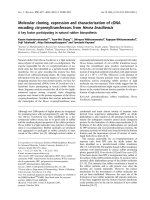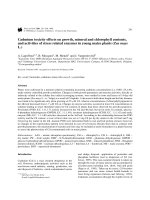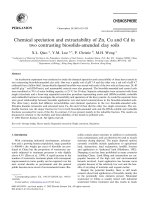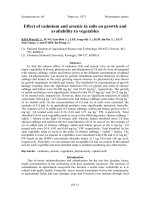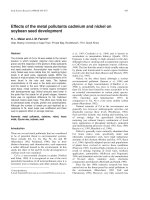Adsorption and desorption of cd
Bạn đang xem bản rút gọn của tài liệu. Xem và tải ngay bản đầy đủ của tài liệu tại đây (112.5 KB, 6 trang )
Adsorption and desorption of cadmium by goethite
pretreated with phosphate
Kaijun Wang, Baoshan Xing
*
Department of Plant and Soil Sciences, Stockbridge Hall, University of Massachusetts, P.O. Box 37245,
Amherst, MA 01003-7245, USA
Received 11 October 2001; received in revised form 21 March 2002; accepted 4 April 2002
Abstract
The adsorption of Cd by oxides or soils have been extensively studied, however, the desorption has received rela-
tively limited attention, especially in the presence of phosphate. In this study, a batch equilibration method was used to
investigate Cd sorption and desorption by goethite pretreated with phosphate. Phosphate not only enhanced Cd ad-
sorption, but also accelerated the adsorption process. Compared with Cd adsorption by goethite alone, phosphate
substantially moved the adsorption curves (edges) to lower pH range, indicative of enhancement of Cd sorption. The
Cd adsorption by the pretreated goethite reached apparent equilibrium within 24 h at 20 °C, while such equilibrium was
not observed after 4 weeks in the absence of phosphate. Cadmium was more readily released from phosphate-treated
goethite. It is believed that phosphate blocked the pores on goethite surface, which lead to the fast adsorption kinetics
and high extraction percentage. These results provided strong support for the diffusion of Cd into goethite particles.
Ó 2002 Elsevier Science Ltd. All rights reserved.
Keywords: Cadmium; Adsorption; Desorption; Phosphate; Goethite; pH
1. Introduction
Cadmium (Cd) is one of the toxic trace metals, which
can be introduced into and accumulate in soils through
agricultural application of sewage sludge and fertilizers,
and/or through land disposal of metal-contaminated
municipal and industrial wastes. Chemical processes
strongly affect the fate and availability of Cd in soils. It
is accepted that concentrations of heavy metals includ-
ing Cd in soil solution are most likely controlled by
sorption–desorption reactions on the surface of soil col-
loidal materials (Brummer et al., 1988; Ainsworth et al.,
1994; Backes et al., 1995; McLaren et al., 1998). As
major components of soil colloidal materials, iron and
manganese oxides play very important roles in the
sorption of heavy metals. Goethite is the most wide-
spread iron oxide in natural environments (Schwert-
mann and Cornell, 2000), and has been well studied and
used for sorption experiments (Fischer et al., 1996;
Strauss et al., 1997; Manceau et al., 2000).
The sorption of heavy metals by soils or oxides has
been extensively studied (Barrow, 1998; Gray et al.,
1998; Eick et al., 1999; Christophi and Axe, 2000;
O’Reilly et al., 2001). Results suggest that sorption ap-
pears to be a multi-step process involving an initial fast
adsorption followed by a slow adsorption and diffusion
into solid particles. Such diffusion might explain the
low reversibility of heavy metal sorption to oxides (Ains-
worth et al., 1994; Brummer et al., 1988; Barrow et al.,
1989). However, this suggestion was not directly derived
from experiments, but from the fitting of sorption data
to various diffusion equations (Barrow, 1986; Krish-
namurti et al., 1999).
Previous studies (Christensen, 1984; Young et al.,
1987; Swift and McLaren, 1991) indicate that desorption
Chemosphere 48 (2002) 665–670
www.elsevier.com/locate/chemosphere
*
Corresponding author. Tel.: +1-413-545-5212; fax: +1-413-
545-3958.
E-mail address: (B. Xing).
0045-6535/02/$ - see front matter Ó 2002 Elsevier Science Ltd. All rights reserved.
PII: S 0 045-6535( 0 2)001 6 7 - 4
is as important as sorption, because it governs the rate
and extent of metal ions released from sorbents. Im-
proved understanding of desorption characteristics may
allow us to better evaluate the bioavailability and po-
tential toxicity of trace metals in soils. However, com-
pared with adsorption research, desorption of heavy
metals received relatively limited attention, especially in
the presence of phosphate (Davis and Upadhyaya, 1996;
McLaren et al., 1998). Phosphorus, one of the major
nutrients for plants, is widely distributed in soils and has
a high affinity for iron hydroxide surfaces. Several in-
vestigators have shown that the adsorption of phosphate
on iron oxides may enhance cation adsorption (Kuo
and McNeal, 1984; Diaz-Barrientos et al., 1990; Venema
et al., 1997). However, the reduction of Cd adsorption
in the presence of phosphate in soils was reported by
Krishnamurti et al. (1999); they attributed this reduction
to the formation of Cd–phosphate complexes in solu-
tion. We want to further examine Cd release in the
presence of phosphate. Therefore, the objectives of this
research were to study the Cd sorption by goethite
pretreated with phosphate, and to determine the effect of
phosphate treatment on Cd desorption kinetics from
goethite.
2. Materials and methods
2.1. Goethite preparation
Goethite was prepared using the method of Schw-
ertmann et al. (1985). Briefly, ferrihydrite was precipi-
tated by rapidly adding 400 ml of a 1 M FeNO
3
solution
to 3600 ml of KOH solution to yield a final OH
À
con-
centration of 0.7 M. The suspension was then stored in
polyethylene bottles at 10 °C for 2 months. After syn-
thesis, the goethite was washed thoroughly with de-
ionized water to remove NO
À
3
and K
þ
, and finally dried
at 60 °C and ground in an agate mortar. The prepared
sample showed a typical X-ray diffraction pattern of
goethite, and only 0.8% of total iron remained soluble in
oxalate solution, indicative of nearly complete crystal-
lization from ferrihydrite. Our goethite was the same
sample as used in a surface topographic study by Fischer
et al. (1996). The goethite had a BET surface area of 75
m
2
/g measured by the method described by Kruse and
Lagaly (1988).
2.2. Adsorption measurement
Goethite suspensions were prepared in 0.01 M
Ca(NO
3
)
2
with 20 mg oxide per milliliter. After ultra-
sonic dispersion, 1 ml aliquots were dispensed into 15 ml
polycarbonate tubes (20 mg/tube). Small amounts of
HNO
3
and NaOH were gradually applied to the sus-
pensions to achieve a pH range between 3 and 8. The
tubes were then made up to 8 ml with 0.01 M Ca(NO
3
)
2
and shaken on an rotary shaker for 14 days at 20 °Cto
reach constant pH. Because it was extremely difficult to
achieve the same pH for replicates, a large number of
samples were used at various pH values rather than
employing duplicates or triplicates at a same pH.
Phosphate treatment was carried out as follows.
One milliliter 0.01 M phosphate [Na
2
HPO
4
in 0.01 M
Ca(NO
3
)
2
] was added to the goethite suspension. After
the samples were thoroughly mixed on a rotary shaker
at 30 rpm for 7 days at 40 °C, 1 ml 10
À4
M Cd [Cd(NO
3
)
2
in 0.01 M Ca(NO
3
)
2
] was added to the tubes (i.e., the
goethite suspensions) to make up to the 10 ml final
volume. Then, the suspensions were ultrasonically dis-
persed and shaken for various reaction times of 15 min,
24 h, 7 days, and 4 weeks at 20 °C. At the end of
each reaction time, the suspensions were centrifuged
and the supernatants were collected for measurements of
pH and Cd concentration. The Cd adsorption in the
absence of phosphate was also prepared following the
same procedure at the same time. The Varian atomic
absorption spectrometer (AAS) with graphite furnace
(SpectrAA 55) was used to determine the Cd concen-
tration.
2.3. Desorption measurement
Cadmium extractions were carried out immediately
after Cd adsorption. The 5 M HCl solution was used as
an extractant. Briefly, samples were centrifuged at 7840
g at the end of adsorption. After the supernatants were
removed carefully, fresh 5 M HCl (10 ml) was added and
mixed with solid particles by ultrasonic dispersion. The
new suspensions were again mixed on the rotary shaker
for a predetermined extraction time. Due to the disso-
lution of goethite in 5 M HCl (Cornell et al., 1976),
extraction times were designed to be 5 min, 30 min, 2 h,
and 4 h for each tube, that is, each tube was sequentially
extracted four times. At the end of each extraction, the
samples were centrifuged at 7840 g for 10 min. The su-
pernatants were decanted from the tubes and the con-
centration of Cd was measured by AAS.
3. Results and discussion
Goethite and phosphate are commonly found in
soils. Under natural conditions, the interaction between
phosphate and goethite is usually in equilibrium before
any addition of exogenous heavy metals into soils. In this
respect, the sorption characteristics of Cd by goethite
pretreated with phosphate may resemble the sorption–
desorption reactions occurring in the natural environ-
ment.
666 K. Wang, B. Xing / Chemosphere 48 (2002) 665–670
3.1. Cadmium adsorption
Cadmium adsorption by goethite was highly pH-
dependent. Almost all Cd was adsorbed at high pHs
for the initial concentration of 10
À5
M. After 15 min
reaction, nearly all Cd were adsorbed at pH P 7:2 in
the absence of phosphate, and at pH P 5:5 in the pres-
ence of phosphate. Fig. 1 shows that Cd adsorption
was greatly enhanced in the presence of phosphate. Al-
though phosphate did not change the shape and slope of
adsorption curves, the adsorption edge shifted distinctly
to lower pH, indicating the substantial enhancement of
Cd adsorption. The pH
50
(the pH value at which 50% of
heavy metal ions were adsorbed) was reduced by up to
1.7 pH units (Table 1). At the reaction time of 15 min,
for example, about 75% at pH 5 and 100% at pH 6 of Cd
ions were adsorbed by the goethite pretreated with
phosphate, while only 1.5% and 23% were adsorbed at
the same pHs in the absence of phosphate. The en-
hanced Cd adsorption could be attributed to the re-
duction of the pH
zpc
(zero point of charge) of goethite
and surface potential after the phosphate treatment
(Kuo and McNeal, 1984). Phosphate sorption increases
surface negative charge and decreases the electrostatic
potential near the solid surface, which might cause an
increase in the Cd surface loading. This result is con-
sistent with that reported by Venema et al. (1997).
Phosphate also altered the adsorption kinetics of
Cd by goethite. The continuous decrease of pH
50
as a
function of reaction time implies that the Cd adsorption
on the untreated goethite did not reach equilibrium after
4 weeks reaction (Table 1). At pH 6, for example, 23% of
Cd was adsorbed at 15 min, while 32%, 37%, and 55% of
Cd was adsorbed at reaction times of 24 h, 7 days, and 4
Fig. 1. Percent Cd adsorption by the phosphate-treated goethite () and untreated goethite () as a function of pH at different reaction
times and a constant temperature of 20 °C.
Table 1
pH
50
a
values of Cd at initial concentration 10
À5
M and 20 °C
Reaction time Phosphate-trea-
ted goethite
Untreated
goethite
Difference
15 min 4.69 6.39 1.70
24 h 4.55 6.24 1.69
7 days 4.54 6.17 1.63
4 weeks 4.52 5.94 1.42
a
pH
50
is defined as such a pH value at which 50% of initial
metal ions are adsorbed.
K. Wang, B. Xing / Chemosphere 48 (2002) 665–670 667
weeks, respectively. However, except for 15 min contact
time, little change in the amount of Cd adsorbed was
observed between times in the presence of phosphate.
These results indicate that the Cd adsorption on goethite
in the presence of phosphate needed 6 24 h to reach
apparent equilibrium at 20 ° C. The acceleration of Cd
adsorption may be caused by blocking and/or occupy-
ing of meso- and micro-pores on goethite surface or
between goethite domains by phosphate (Madrid and de
Arambarri, 1985; Torrent et al., 1990; Strauss et al.,
1997). As a result, Cd ions might not be able to diffuse
further into the pores and the overall adsorption process
was faster.
These meso- and micro-pores have been proposed as
pathways for diffusion of metal ions into oxide matrix
following initial fast adsorption (Brummer et al., 1988;
Bibak et al., 1995). Fischer et al. (1996) reported that the
pores on goethite surface were 20–30 nm wide and be-
came narrower towards the interior of the crystals to 2
nm or less. The diffusion of ions may be not limited from
the pore entrances (20–30 nm), but with increasing pore
depth and decreasing pore size, only small ions can
penetrate into the narrow pores. Because phosphate ions
are bigger than Cd ions (0.22 nm in radius for phos-
phate, 0.097 nm for Cd
2þ
), it is possible for phosphate
ions to diffuse into and block such pores during pre-
treatment. For some micro-pores, phosphate may only
diffuse partway into the pores or block the entrance,
resulting in rapid sorption kinetics.
3.2. Cd desorption
Several authors have demonstrated that the sorption
process of trace metals is not completely reversible, and
explanations have been proposed for such observations,
including diffusion of trace metals within oxide particles
or into micro-pores (Brummer et al., 1988; Backes et al.,
1995; Gray et al., 1998), precipitation (Farrah and
Pickering, 1978), incorporation of metals into oxides
(McKenzie, 1970; Ainsworth et al., 1994), and re-
adsorption (Davis and Upadhyaya, 1996). A wide range
of solutions were used as extractants in these studies,
including Ca(NO
3
)
2
, HNO
3
, NaCl, EDTA, and NTA.
These solutions exhibit differences in their extraction
ability. In our study, 5 M HCl was used as an extractant
because such a strong acid would effectively release Cd
from the goethite particle surface and prevent re-
adsorption of Cd (Farrah and Pickering, 1978). In the
present work, we focused on the samples with nearly
100% Cd adsorption; in this case, the pHs of initial
sorption reaction ranged from 5 to 8. Our results showed
that most Cd was released from goethite after a 400 min
extraction (cumulative time).
Fig. 2 shows the cumulative average percentage of Cd
released as a function of extraction time for the phos-
phate-treated goethite. Because of a slight difference in
Cd recovery between pHs from 5 to 8, the average values
were used to demonstrate the overall effect of contact
time. As one may see, there was no substantial difference
in Cd adsorption for reaction times beyond 24 h (Fig. 1),
but the Cd recovery decreased with increasing contact
time (Fig. 2). For 15 min adsorption, about 95% and
nearly all of Cd adsorbed were released into solution
after 5 and 400 min extraction, respectively. But for 4
weeks adsorption, percentages were 82% at 5 min and
93% at 400 min. One possible reason is that not all the
pores were blocked by phosphate, which might be still
available for Cd diffusion. Another possibility is that the
sorption of phosphate by goethite might not reach
equilibrium during pretreatment. As a consequence,
phosphate could diffuse further into the pores during Cd
sorption and Cd diffusion would be extended with in-
creasing contact time. Also, the dissolution rate of go-
ethite–phosphate complex may become slower with
time, which could cause lower Cd extraction.
In an attempt to examine the effect of phosphate
pretreatment on Cd desorption, the Cd extraction from
goethite in the absence of phosphate was carried out for
the 4 weeks sorption experiments (Fig. 3). It is clear that
the phosphate pretreatment greatly enhanced Cd de-
sorption. Moreover, we might have underestimated the
difference in Cd desorption between the two systems
because goethite treated with phosphate dissolves more
slowly in 5 M HCl than the phosphate-free goethite
(Strauss et al., 1997); more Cd would be released from
phosphate-treated goethite assuming its dissolution rate
is the same as that of phosphate-free goethite and, thus,
the difference on the percentage of Cd extraction would
be even greater than that we reported here. Nevertheless,
Fig. 2. Effect of contact time on the average percent Cd re-
leased (on a cumulative basis for both time and Cd recovery)
from the phosphate-treated goethite. Some error bars are in-
visible because the symbols are greater than the error bar size
(error bar represents one standard deviation).
668 K. Wang, B. Xing / Chemosphere 48 (2002) 665–670
results support our hypothesis that phosphate can block
pores of goethite, which hinders Cd diffusion into the
inner surface binding sites as Cd ions did in the absence
of phosphate. As a result, more Cd accumulated on the
particle surface or near surface in the presence of
phosphate. Such Cd distribution would be easier for
extraction.
In this study, the samples were thoroughly mixed by
ultrasonic dispersion. It is reasonable to assume that the
goethite particles were evenly dissolved from surface in
HCl solution. Under this assumption, our results sup-
port the diffusion of Cd into solid phase or the meso-
and micro-pores of goethite particles with increasing
contact time (Brummer et al., 1988; Backes et al., 1995).
One may try to use re-adsorption or precipitation to
explain the results reported here. However, we disagree
for the following reasons. First of all, 5 M HCl is such a
strong extractant that the possibility of re-adsorption
would be ruled out. Secondly, HCl would be able to
dissolve any precipitated hydrous oxide species of heavy
metals (Farrah and Pickering, 1978). If precipitation was
involved in the Cd sorption on goethite, more Cd would
be released from goethite at higher pHs of initial sorp-
tion reaction due to the higher Cd sorption. In fact, a
slightly decreasing Cd recovery was observed with in-
creasing pH from 5 to 8 for a given adsorption period
(Table 2), which can be explained well by diffusion. In
the pH range from 5 to 8, the adsorption of phosphate
on goethite decreased from about 190 to about 165
lmol/g after 7 day sorption (Fig. 4). Therefore, more
pores would be blocked by phosphate at lower pHs,
which would result in the increase of Cd extraction. The
opposite would be true for high pHs.
4. Conclusion
Phosphate treatment greatly influenced Cd sorption.
Not only did phosphate enhance Cd adsorption, but
also accelerated the adsorption kinetics. The adsorption
edges shifted to lower pH substantially in the presence of
phosphate, indicative of enhanced Cd adsorption. The
adsorption of Cd did not reach equilibrium after 4 weeks
of reaction in the absence of phosphate; however, for the
Fig. 3. Average percent Cd released (on a cumulative basis for
both time and Cd recovery) from the phosphate-treated go-
ethite (
) and untreated goethite () after 4 weeks adsorption at
20 °C (error bar represents one standard deviation).
Table 2
Percent Cd released from the phosphate-treated goethite after 5
min extraction by 5 M HCl
Adsorption period pH Percentage
released (%)
15 min 5.38 95.4
6.18 95.1
6.51 94.9
6.92 94.0
7.21 92.4
24 h 5.43 89.4
6.07 88.3
6.51 88.4
6.96 87.1
7.23 85.6
7 days 5.36 87.5
6.07 86.4
6.50 86.2
6.93 84.0
7.22 83.9
4 weeks 5.20 83.1
5.92 82.8
6.52 79.4
6.97 79.0
Fig. 4. Amount of phosphate adsorbed by goethite after 7 days
at 10
À3
M initial concentration and 40 °C, showing a gradual
decrease of sorption with increasing pH.
K. Wang, B. Xing / Chemosphere 48 (2002) 665–670 669
treated goethite, Cd adsorption reached apparent equi-
librium within 24 h, as indicated by a relatively constant
pH
50
. Cadmium was more readily released from the
phosphate-treated goethite. Both adsorption and extrac-
tion results support the hypothesis that phosphate can
block/occupy meso- and micro-pores of goethite parti-
cles during the pretreatment, causing fast sorption and
desorption processes. Therefore, these results provided
strong support for the diffusion of Cd into goethite
particles during sorption.
Acknowledgements
Authors thank Dr. G.W. Brummer for his helpful
discussion and for providing the goethite material.
References
Ainsworth, C.C., Pilon, J.L., Gassman, P.L., Van Der Sluys,
W.G., 1994. Cobalt, cadmium, and lead sorption to hydrous
iron oxide: residence time effect. Soil Sci. Soc. Am. J. 58,
1615–1623.
Backes, C.A., McLaren, R.G., Rate, A.W., Swift, R.S., 1995.
Kinetics of cadmium and cobalt desorption from iron and
manganese oxides. Soil Sci. Soc. Am. J. 59, 778–785.
Barrow, N.J., 1986. Testing a mechanistic model. II. The effect
of time and temperature on the reaction of zinc with a soil.
J. Soil Sci. 37, 277–286.
Barrow, N.J., 1998. Effects of time and temperature on the
sorption of cadmium, zinc, cobalt, and nickel by a soil.
Aust. J. Soil Res. 36, 941–950.
Barrow, N.J., Gerth, J., Brummer, G.W., 1989. Reaction
kinetics of the adsorption and desorption of nickel, zinc,
and cadmium by goethite. II. Modeling the extent and rate
of reaction. J. Soil Sci. 40, 437–456.
Bibak, A., Gerth, J., Borggaard, O.K., 1995. Retention of
cobalt by pure and foreign-element associated goethites.
Clays Clay Miner. 43, 141–149.
Brummer, G.W., Gerth, J., Tiller, K.G., 1988. Reaction kinetics
of the adsorption and desorption of nickel, zinc and cad-
mium by goethite. I. Adsorption and diffusion of metals.
J. Soil Sci. 39, 37–51.
Christensen, T.H., 1984. Cadmium soil sorption at low
concentrations: II. Reversibility, effect of changes in solute
composition, and effect of soil aging. Water Air Soil Pollut.
21, 115–125.
Christophi, C.A., Axe, L., 2000. Competition of Cd, Cu, and Pb
adsorption on goethite. J. Environ. Eng.––ASCE 126 (1),
66–74.
Cornell, R.M., Posner, A.M., Quirk, J.P., 1976. Kinetics and
mechanisms of the acid dissolution of goethte (a-FeOOH).
J. Inorg. Nucl. Chem. 38, 563–567.
Davis, A.P., Upadhyaya, M., 1996. Desorption of cadmium
from goethite (a-FeOOH). Water Res. 30, 1894–1904.
Diaz-Barrientos, E., Madrid, L., Contreras, M.C., Morillo, E.,
1990. Simultaneous adsorption of zinc and phosphate on
synthetic lepidocrocite. Aust. J. Soil Res. 28, 549.
Eick, M.J., Peak, J.D., Brady, P.V., Pesek, J.D., 1999. Kinetics
of lead adsorption/desorption on goethite: residence time
effect. Soil Sci. 164 (1), 28–39.
Farrah, H., Pickering, W.F., 1978. Extraction of heavy
metal ions sorbed on clays. Water Air Soil Pollut. 9, 491–
498.
Fischer, L., Zur Muhlen, E., Brummer, G.W., Niehus, H., 1996.
Atomic force microscopy (AFM) investigations of the
surface topography of a multidomain porous goethite.
Eur. J. Soil Sci. 47, 329–334.
Gray, C.W., McLaren, R.G., Roberts, A.H.C., Condron, L.M.,
1998. Sorption and desorption of cadmium from some New
Zealand soils: effect of pH and contact time. Aust. J. Soil
Res. 36, 199–216.
Krishnamurti, G.S.R., Huang, P.M., Kozak, L.M., 1999.
Sorption and desorption kinetics of cadmium from soils:
influence of phosphate. Soil Sci. 164, 888–898.
Kruse, H.H., Lagaly, G., 1988. Automatische apparatur zur
volumetrischen gasadsorptionsmessung. GIT Fachzeitsch-
rift fur das labor 32, 1096–1100.
Kuo, S., McNeal, B.L., 1984. Effects of pH and cadmium
sorption by a hydrous ferric oxide. Soil Sci. Soc. Am. J. 48,
1040–1044.
Madrid, L., de Arambarri, P., 1985. Adsorption of phosphate
by two iron oxides in relation to their porosity. J. Soil Sci.
36, 523–530.
Manceau, A., Nagy, K.L., Spadini, L., Ragnarsdottir, K.V.,
2000. Influence of anionic layer structure of Fe-oxyhydrox-
ides on the structure of Cd surface complexes. J. Colloid
Interf. Sci. 228, 306–316.
McKenzie, R.M., 1970. The reaction of cobalt with manganese
dioxide minerals. Aust. J. Soil Res. 8, 87–106.
McLaren, R.G., Backes, C.A., Rate, A.W., Swift, R.S., 1998.
Cadmium and cobalt desorption kinetics from soil clays:
effect of sorption period. Soil Sci. Soc. Am. J. 62, 332–
337.
O’Reilly, S.E., Strawn, D.G., Sparks, D.L., 2001. Residence
time effects on arsenate adsorption/desorption mechanisms
on goethite. Soil Sci. Soc. Am. J. 65, 67–77.
Schwertmann, U., Cambier, P., Murad, E., 1985. Properties of
goethites of varying crystallinity. Clays Clay Miner. 33,
369–378.
Schwertmann, U., Cornell, R.M., 2000. Iron Oxides in the
Laboratory. Wiley–VCH, Weinheim.
Strauss, R., Brummer, G.W., Barrow, N.J., 1997. Effects of
crytallinity of goethite: II. Rates of sorption and desorption
of phosphate. Eur. J. Soil Sci. 48, 87–99.
Swift, R.S., McLaren, R.G., 1991. Micronutrient adsorption
by soils and soil colloids. In: Bolt, G.H. et al. (Eds.),
Interactions at the Soil Colloid–Soil Solution Interface.
Kluwer Academic Publishers, Dordrecht, Netherlands,
pp. 257–292.
Torrent, J., Barron, V., Schwertmann, U., 1990. Phosphate
adsorption and desorption by goethites differing in crystal
morphology. Soil Sci. Soc. Am. J. 54, 1007–1012.
Venema, P., Hiemstra, T., van Riemsdijk, W.H., 1997. Inter-
action of cadmium with phosphate on goethite. J. Colloid
Interf. Sci. 192, 94–103.
Young, T.C., DePinto, J.V., Kipp, T.W., 1987. Adsorption and
desorption of Zn, Cu and Cr by sediments from the Raisin
River. J. Great Lakes Res. 13, 353–366.
670 K. Wang, B. Xing / Chemosphere 48 (2002) 665–670
